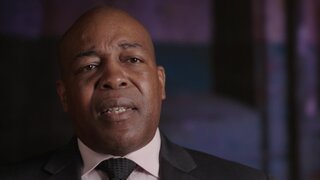Create a free profile to get unlimited access to exclusive videos, breaking news, sweepstakes, and more!
What Makes A Good Detective? A Retired NYPD Chief Of Detectives Reveals What It Takes
Oxygen digital correspondent Stephanie Gomulka speaks with retired NYPD Chief of Detectives Robert K. Boyce about the jaw-dropping cases featured in "New York Homicide."
New York City is home to iconic landmarks, world famous museums, amazing restaurants, and plenty of interesting people. It's also a place where some of the most shocking, jaw-dropping crimes have been committed.
These crimes, ones that could only happen in New York City, are featured in the new Oxygen series "New York Homicide," premiering Saturday, January 1 at 9/8c on Oxygen. Ahead of the show's premiere Oxygen digital correspondent Stephanie Gomulka spoke with retired NYPD Chief of Detectives Robert K. Boyce, who is featured in the new series, about what it takes to a good NYPD detective.
"We have about 6,000 detectives in the NYPD, the largest detective bureau in the country," Boyce told Gomulka. " ... You have to understand, detectives, they're a little bit different from other kinds of police officers. These cases go into their head 24/7 ... it's a 24/7 issue with detectives. It's not something you leave at the door when you go home ... it stays with you. It has to stay with you."
A good detective is one with "the unwavering vigilance to go forward and work hours," a "committed" person who wants to bring justice to a case, according to Boyce.
He also touched on the various different aspects of working in the NYPD, noting they even have a SCUBA team as part of the NYPD Harbor Unit, which does search and rescue in the waters that surround New York City.
"If we have information that someone put a gun in the water we will call out the scuba team and they'll find it more often than not," he explained.
When asked about the cases featured in "New York Homicide" that have stuck with him the most, Boyce pointed to the murder of Joe Comunale and a shocking attack at the Metropolitan Opera House.
"[Joe Comunale] was young man out for a night out in Manhattan ... he was caught up in something he couldn't get out of. He was in the wrong place at the wrong time and he couldn't get out of it," Boyce recalled, adding "the arrogance of the perpetrators" is what made the case stick out to him.
The incident at the Metropolitan Opera House, meanwhile, happened in July 1980, when a violinist named Helen Mintiks vanished during a performance intermission. She was later found dead in a ventilation shaft on the third floor of the opera house, The Washington Post reported in 1980. She was naked and had been bound and gagged, and had died from a fall from the roof down the shaft. The case made headlines and became dubbed "The Phantom Of The Opera Murder."
This case, Boyce said, was an example of "good old-fashioned detective work" as investigators had the difficulty of solving a murder back in 1980 (before many of the forensic advancements we have today were around) and operating in a "news-frenzied environment."
For more on these cases, aspects of being a NYPD detective, and more, watch the videos, above. And make sure to tune in to the new Oxygen series "New York Homicide," premiering Saturday, January 1 at 9/8c on Oxygen.






















